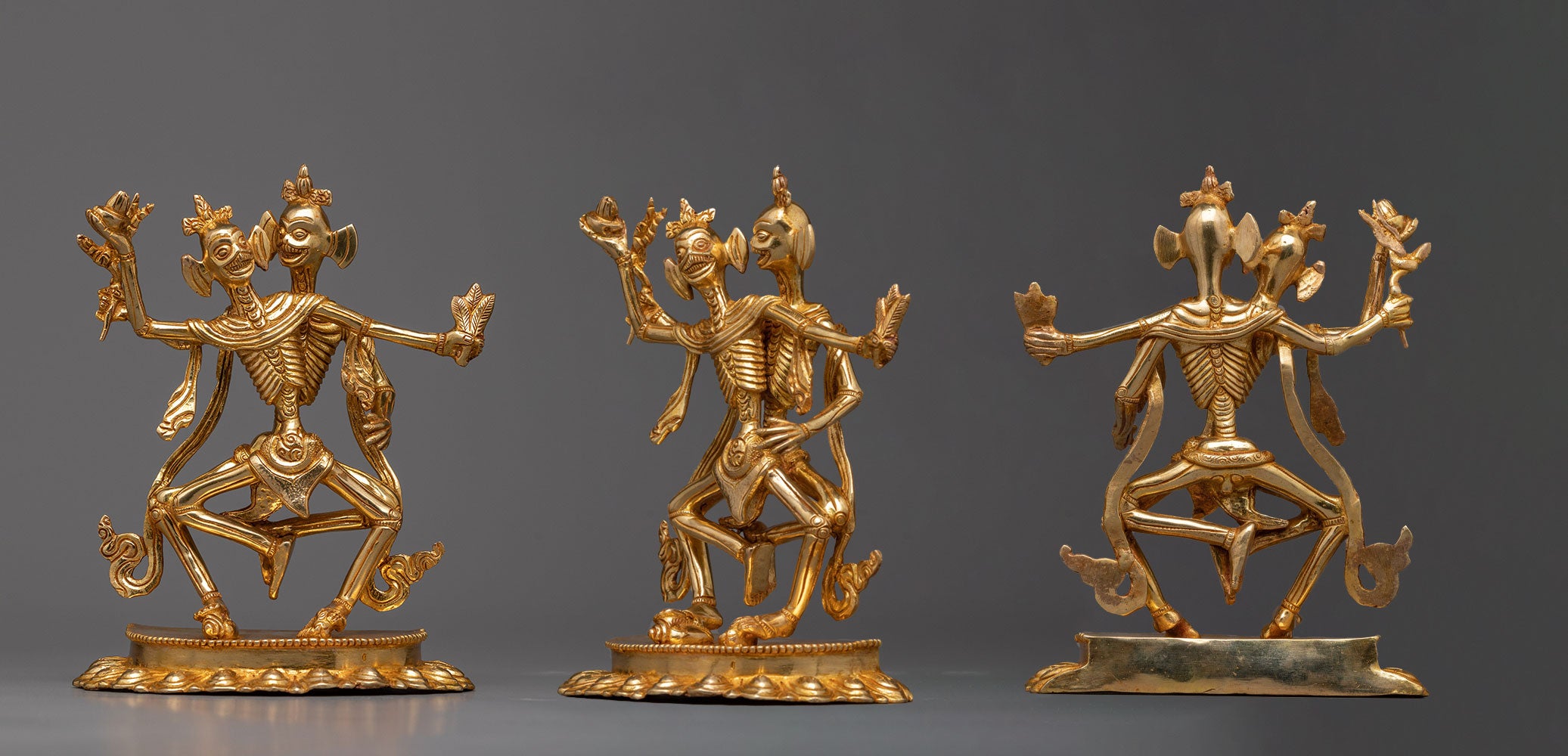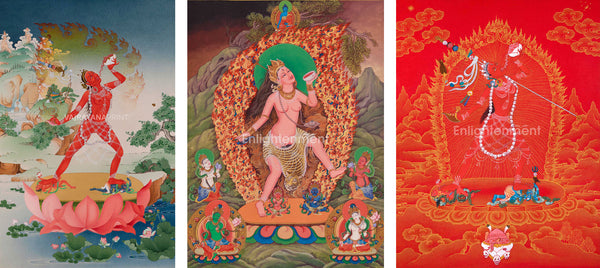Dance of the Divine: The Ritualistic Traditions of Tibetan Citipati
Among the most captivating and stunning characters in Buddhist iconography are the Citipati, who are sometimes misinterpreted and disregarded by people.
These skeletal figures, seen amid a dance, symbolize much more than a macabre preoccupation with death; they are living examples of fundamental lessons about impermanence, the life-death cycle, and the way to attachment-free enlightenment.
Key Takeaways
- The Citipati are symbolic representations in Tibetan Buddhism, often associated with the Charnel Grounds and the cycle of life and death.
- They serve as reminders of the impermanence of life and the importance of liberation from material attachments.
- The Citipati are often depicted in art and rituals, particularly in the Dance of the Skeletons, which monks perform during specific Tibetan festivals.
Origins in Buddhist Mythology

In the narrative of the Citipati, several key themes emerge:
- Impermanence: Their skeletal structure is a stark reminder of life's fleeting existence.
- Detachment: Their narrative emphasizes the value of separating oneself from the physical world.
- Enlightenment: Their continuous meditation, even in death, symbolizes the road to enlightenment.
| Aspect | Details |
| Origins | Rooted in a story of two ascetic monks in Buddhist mythology |
| Symbolism | Represents impermanence, detachment, and enlightenment |
| Cultural Role | Integral to Tibetan Buddhism, featured in art and ritual dances |
| Teachings | Encourage reflection on the nature of life and the importance of spiritual practice. |
Physical Attributes and Iconography of the Shri Citipati
The Citipati is an intriguing feature of Buddhist imagery, particularly in the Vajrayana and Tibetan traditions. Their representation is rife with symbolism, conveying profound lessons about mortality, impermanence, the cycle of life and death, and freedom from samsara.

Skeleton Form:
The Citipati's skeleton distinctive look is its most notable characteristic. They are shown as skeletons, sometimes with limited flesh or skin that has been ripped, underscoring the idea of impermanence and the fleeting essence of physical life.
This acts as a stark reminder that death is a necessary and inescapable aspect of existence, which helps people come to terms with and accept their impermanence (Anicca).
The skeleton shapes of the Citipati came to represent a disassociation from the material world and ego's delusions.
Expressive Poses:
The Citipati are frequently shown in lively, frequently dancing-like stances. These stances, which symbolize the dance of life and death and the delight of breaking free from the cycle of reincarnation, can range from happy to ominous.
The dance represents the everlasting flow of life, the dynamic interaction between creation and destruction, and the ultimate liberation that comes with knowledge.
Flames around Them:
The Citipati are frequently seen with flames around them, signifying the transformational power of fire. In this perspective, fire stands for reality's transient and constantly shifting character. Additionally, it alludes to the yogic technique known as tummo, or inner fire meditation, which turns ignorance into knowledge.
Attributes and Implements: The Citipati may hold various attributes and implements, such as:
- Damaru (Hand Drum): Depicting both the transience of all things and the primal melody of creation.
- The Kapala, or skull cup, symbolizes converting passions and wants into knowledge. It is frequently filled with blood or honey.
- Trident: This symbol depicts mastery over the three domains of life or the three deadly sins of aversion, desire, and ignorance.
- Rope or Noose: Symbolizes the last release from connection and its binding quality.
Ornamentation:
Despite their skeleton structure, Citipati can be ornamented with crowns, necklaces, and other items, most commonly constructed of skulls and bones.
These ornaments, which change death emblems into beautiful and meaningful items, highlight the idea of impermanence even more. The decorations also represent the triumph over death by realizing and embracing impermanence.
Companion Figures:
The Citipati are often seen with consorts or embracing a female skeleton in a yab-yum (male-female union), representing the marriage of compassion and emptiness or knowledge and method (Prajna and Upaya).
A key idea in Vajrayana Buddhism is that this union symbolizes the unification of opposites and the non-dual character of reality.
Contextual Setting:
In Tibetan Buddhism, charnel grounds and graves are thought to be potent sites of change, which is why they are frequently positioned there. These surroundings highlight the Citipati's associations with death, impermanence, and activities meant to realize the essence of emptiness and attain freedom.
The Tale of the Citipati: The Lords of the Cemetery

Two austere monks were fervently committed to their spiritual practice. They had given up all material belongings and aspirations to devote their life to meditation and enlightenment. These monks were lost in their meditations, so much so that they forgot everything around them, even the passing of time.
A gang of robbers happened upon them one day while they were meditating in a remote charnel ground—a location where the corpses of the deceased were left exposed to the weather and scavenger animals.
The robbers mercilessly murdered the monks, supposing them to be mendicants carrying expensive items, not realizing that the monks had nothing of worth.
The robbers then disposed of their bodies like the others there, leaving them in the charnel ground with little fanfare.
But because of their great spiritual development and contemplative techniques, the two monks' spirits were freed from the mundane cycle of death and rebirth. They decided to stay in the charnel ground and become defenders of the lessons on impermanence rather than seeking rebirth or going on to the next life.
The monks' souls eventually changed into the Citipati, the Lords of the Cemetery. They danced boldly and gleefully amid the dead and funeral pyres, appearing as skeletons, their shapes representing the ultimate truth of impermanence and the emptiness of physical existence.
Their dance served as a macabre but poignant reminder that physical connection to the body may be a cause of sorrow and that life and death are merely two sides of the same coin.
They were regarded as the cemetery's guardians, ensuring that outside forces did not bother the deceased and that the charnel ground continued to be a hallowed area for meditation and spiritual exercise.
Furthermore, Citipati's narrative is meant to educate practitioners on the value of upholding spiritual discipline and attention even in death. Their history tells us that absolute freedom is gained by accepting the impermanence of life, seeing that it is a cycle, and overcoming the worries that keep us trapped in samsaric existence.
The Citipati are significant emblems of the basic teachings of Buddhism, and they are more than just fascinating people from folklore. They serve as a reminder of the transience of existence, the value of distancing oneself from the physical world, and the potential for enlightenment. The Citipati provide essential insights into the essence of life and the way to freedom through their myths, symbols, and celebration rites.


